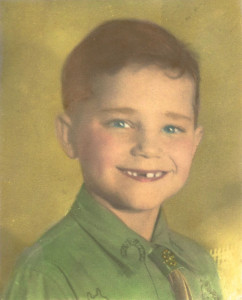A portrait of: Michael “Mickey” Fagan (b. 1929 South Holland, IL – d. 2002 Chicago, IL)
Michael “Mickey” Fagan could trace a direct line to his family’s steel mill roots back to his great-grandfather, Charles Fagan (b.1856 – d.1937), son of Michael & Biddy Fagan, who began working at the US Steel South Works (then called North Chicago Railway Mill Company), when it opened in 1882. Every generation since has had multiple family members working for the steel giants.

Charles Fagan (b.1856 – d.1937) taken 1875
Mickey’s sons, Peter and Joey, also worked in Chicago’s Southside mills only to have their careers cut short in 2001 when the last of Chicago’s mighty blast furnaces, located at Acme Steel Coke Plant on Torrance Avenue, was snuffed out, putting an end to steel making in Chicago and to the Fagan’s 119 year steel family history. The family proudly boasts five successive generations of steel workers at the Iroquois, US, Republic, Illinois, Acme, and Wisconsin Steel plants. They all lived within a few miles of each other in the tightly knit South Shore neighborhood. As a child, Mickey, along with his family, would often take summer vacations together at his great uncle Liam’s & Leonard’s lodge and mineral spa in the remote wooded hills of Benson’s Corner, Wisconsin, (see backstory for When I Was Young) far from the forest of belching smokestacks and the glow of the open-hearth furnaces of the surrounding mills.
Mickey was only eight years old when his father, Charles “Tre” Fagan III (b.1912 – d.1980) and grandfather, Charles Fagan, Jr. (b.1885 – d. 1955) witnessed one of the most important events in American labor history: the Memorial Day Massacre, which occurred on a spit of land in front of the Republic Steel Plant adjacent to the railway tracks along Torrance Avenue on Memorial Day, May 30, 1937. The Memorial Day Massacre of 1937 (so called by labor sympathizers), or The Republic Steel Riot (so called by those who were not), took the lives of 10 protesters including one woman and 3 children, and injured more than 600 others. Forty police officers were also injured. The Steel Workers Organizing Committee (SWOC) organized a peaceful protest that was to take place that Memorial Day. The SWOC was attempting to organize the steel workers as part of the group of smaller steel companies known as “Little Steel”. When Republic refused to recognize the union, the workers went out on strike demanding collective bargaining rights and decent wages. Tom Girdler, who ran Republic said, “I’d rather go back to hoeing potatoes for a living than agree to workers’ demands.” Thousands of workers, their families, labor activists and other supporters met that Memorial Day at a local dance hall, Sam’s Club, on 112th and Green Bay Avenue and decided to parade their picket in front of the Republic Steel main gate. When the group arrived at 116th Street, a line of 500 police officers blocked their advance. Tempers flared.
There are conflicting reports as to what happened next. Armed with weapons and ammunition provided by Republic Steel’s own stockpiles, the police had $40,000 worth of machine guns, rifles, shotguns, revolvers, tear gas canisters and launchers and 10,000 rounds of ammunition to use against strikers. Republic alone had more supplies than any law enforcement agency in the entire country. A gunshot rang out. As the police moved forward in pursuit of the panicked and retreating hysterical mass, they began to club and beat the protesters to the ground. Dozens were arrested and thrown into “Paddy” wagons. Many were seriously wounded. When the day ended, 4 people had been killed, and 6 would later die in the hospital, all shot in the back. Another 30 survived gunshot wounds. More than 600 were treated at area hospitals for injuries. The strike was broken and it wasn’t until a decade later that the union finally gained recognition.

Michael ‘Mickey’ Fagan c.1933
Mickey began working at Republic Steel when he was 17. The demand for steel and labor were high. Like his father and grandfather before him, Mickey remained a staunch union man, active as a union steward and an advocate for workers’ rights. He raised his family during the glory years of steel in Chicago, the 1960s and early ‘70s, churning out more than a million tons of slab a year at the Southside works. But the tide quickly turned for the industry. Unable to compete with foreign imports and labor costs, Republic began laying-off workers by the thousands and dismantling portions of its nearly mile long Southside plant. In a final and desperate move to avoid bankruptcy the company merged with LTV Corporation in 1984. It proved the beginning of the end to the steel giant.

Abandoned Steel Mill, South Side Chicago
Mickey retired in 1992 on a paltry pension as the company’s pension fund established by Republic had been raided by LTV. By the mid-‘90s the once mighty Republic Steel works was completely leveled. It remains a barren wasteland. Mickey and his wife (Hannah Koschalk b.1932 – d. 2012) lived out their days in the Southside bungalow they purchased when they were newlyweds in 1951.
Read More
The Memorial Day Massacre of 1937 (The Republic Steel Riot)
Paramount Newsreel: The Memorial Day Massacre of 1937 (See 11:00 mark)
Rusted Dreams – Hard Times in a Steel Community by D. Bensman & R. Lynch

